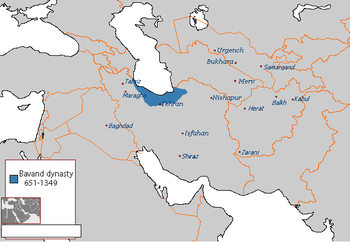آل باوند
(تم التحويل من أسرة باوند)
أسرة باوند باوندیان | |||||||||
|---|---|---|---|---|---|---|---|---|---|
| 651–1349 | |||||||||
 خريطة دولة آل باوند في أقصى اتساع لها | |||||||||
| العاصمة | فريم (651–1074) ساري (1074–1210) آمل (1238–1349) | ||||||||
| اللغات الشائعة | الفارسية لغات القزوين | ||||||||
| الدين | الزرادشتية (651-842) الإسلام السني (842-964) الشيعة الإثناعشرية (964-1349) | ||||||||
| الحكومة | ملكية | ||||||||
| إسپهبذ | |||||||||
• 651-665 | فروخزاد (الأول) | ||||||||
• 1334–1349 | الحسن الثاني (الأخير) | ||||||||
| الحقبة التاريخية | العصور الوسطى | ||||||||
• تأسست | 651 | ||||||||
• الفتح الأفراسيابي | 1349 | ||||||||
| |||||||||
جزء من سلسلة عن |
|---|
| تاريخ إيران |
 |
|
خط زمني |
أسرة باوند (وتُكتب أيضاً باڤند)، أو ببساطة باونديون، كانت أسرة حاكمة إيرانية حكمت أجزاء من طبرستان (مازندران) في ما هو الآن شمال إيران من سنة 651 وحتى 1349، متأرجحة بين الاستقلال التام والخضوع كتابع لحكام محليين أقوياء.
حكام آل باوند
كيوسية
- فروخزاد (651–665)
- Valash (usurper, 665–673)
- Surkhab I (673–717)
- Mihr Mardan (717–755)
- Surkhab II (755–772)
- شروين الأول (772–817)
- شهريار الأول (817–825)
- Shapur (825)
- Rule by the Karenid Mazyar (825-839)
- Qarin I (839–867)
- رستم الأول (867–895)
- شروين الثاني (896–930)
- شهريار الثاني (930–964)
- رستم الثاني (964–979)
- المرزبان (979–986)
- شروين الثالث (986)
- شهريار الثالث (986-987)
- المرزبان (987–998)
- شهريار الثالث (998)
- المرزبان (998-1006)
- أبو جعفر محمد (???-1027)
- Qarin II (1057-1074)
إسپهبذية
- شهريار الرابع (1074–1114)
- Qarin III (1114–1117)
- Rustam III (1117–1118)
- Ali I (1118–1142)
- Shah Ghazi Rustam IV (1142–1165)
- Hasan I (1165–1173)
- Ardashir I (1173–1205)
- Rustam V (1205–1210)
كينخوارية
- Ardashir II (1238–1249)
- Muhammad (1249–1271)
- Ali II (1271)
- Yazdagird (1271–1300)
- Shahriyar V (1300–1310)
- Kay Khusraw ibn Yazdagird (1310–1328)
- Sharaf al-Muluk (1328-1334)
- Hasan II (1334–1349)
انظر أيضاً
الهامش
المصادر
- Bosworth, C. E. (1968). "The Political and Dynastic History of the Iranian World (A.D. 1000–1217)". In Boyle, J.A. (ed.). The Cambridge History of Iran, Volume 5: The Saljuq and Mongol periods. Cambridge: Cambridge University Press. pp. 1–202. ISBN 0-521-06936-X.
{{cite book}}: External link in|chapterurl=|ref=harv(help); Unknown parameter|chapterurl=ignored (|chapter-url=suggested) (help) - Frye, R. N. (1986). "Bāwand". The Encyclopedia of Islam, New Edition, Volume I: A–B. Leiden and New York: BRILL. p. 1110. ISBN 90-04-08114-3.
{{cite encyclopedia}}: Invalid|ref=harv(help) - Madelung, W. (1975). "The Minor Dynasties of Northern Iran". In Frye, R. N. (ed.). The Cambridge History of Iran, Volume 4: From the Arab Invasion to the Saljuqs. Cambridge: Cambridge University Press. pp. 198–249. ISBN 978-0-521-20093-6.
{{cite book}}: External link in|chapterurl=|ref=harv(help); Unknown parameter|chapterurl=ignored (|chapter-url=suggested) (help) - Madelung, W. (1984). "ĀL-E BĀVAND (BAVANDIDS)". Encyclopaedia Iranica, Vol. I, Fasc. 7. London u.a.: Routledge & Kegan Paul. pp. 747–753. ISBN 90-04-08114-3.
{{cite encyclopedia}}: Invalid|ref=harv(help) - Pourshariati, Parvaneh (2008). Decline and Fall of the Sasanian Empire: The Sasanian-Parthian Confederacy and the Arab Conquest of Iran. London and New York: I.B. Tauris. ISBN 978-1-84511-645-3.
{{cite book}}: Invalid|ref=harv(help) - Ibn Isfandiar, Mohammad b. Hasan. Tarikh-e Tabaristan, ed. M. Mehrabadi, Tehran: Ahl-e Qalam, 1381 [2002].
- Kasravi, Ahmad. Shahriaran-e Gomnam, Tehran: Amir Kabir, 1957.
- Mar'ashi, Sayyed Zahiruddin. Tarikh-e Tabaristan o Royan of Mazandaran, ed. by Bernhard Darn, St. Petersburg, 1850 (Tehran Edition: Gostareh, 1363 [1984]).
وصلات خارجية
الكلمات الدالة:
This article contains content from Wikimedia licensed under CC BY-SA 4.0. Please comply with the license terms.